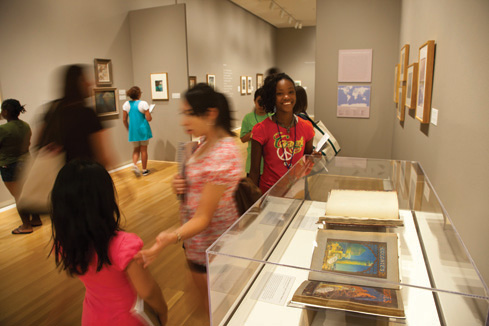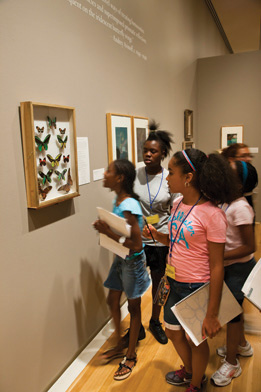 Fall 2011
Fall 2011|
Summer Dreaming
Summer Dreamers explore the Andrey Avinoff exhibition, a mix of art and natural historyPhoto: Tom LittleOn a recent hot July afternoon, Carnegie Museum of Natural History invited 16 middle school students to explore a section of the museum that for them was strange, exciting, and completely unknown: the multi-tiered storeroom housing a vast collection of preserved amphibians and reptiles. At the museum, we call it the “Herp House,” short for herpetology. “What is THIS?” exclaimed Brianna Snyder, momentarily transfixed by her discovery of a gallon-sized glass jar containing a snake-like specimen whose tapered snout did not quite match her visual definition of a serpent. “Congratulations!” replied Steve Rogers, collection manager for birds, amphibians, and reptiles, as he reached the rack of shelves where the sixth grader stood. “You found what’s known as an amphisbaenian. It’s one of the more unusual specimens in this collection. Some people call them worm lizards, but they are a reptile with features of both snakes and lizards.” This behind-the-scenes visit was a special event, and it included a lively discussion about the collection’s value as unique documentation of our planet’s biological diversity. On the other hand, this particular group’s engagement in the life, work, and materials of the museum had already become an established routine. For the previous three weeks, on the very same afternoons many of their peers spent at local swimming pools, the group of sixth, seventh, and eighth graders from nine Pittsburgh neighborhoods explored the overlapping worlds of art and science through a program jointly planned and produced by Carnegie Museum of Art and Carnegie Museum of Natural History. I was able to see such personally familiar territory as the Dinosaurs in Their Time exhibition and the Hall of Architecture through the eyes of a new generation of Pittsburghers.
The tweens’ and teens’ daily immersion in the museum world was part of a broader effort on the part of the Pittsburgh Public Schools to reduce what educators term “summer learning loss,” a recurring and compounding pheno-menon that has been strongly linked to the persistent reading achievement gap separating many low-income students from those with greater financial resources. Titled Summer Dreamers Academy, the innovative five-week project operated for the second consecutive year with support from both federal and foundation funding streams. In practice, the ambitious city-wide effort, which involved some 30 Pittsburgh organizations, provided a sequential series of afternoon programs for groups of students who spent their mornings participating in literacy-building activities at six different school district buildings. This summer’s full menu of afternoon programs, ranging from playwriting to bicycle repair, was first presented to students and their parents in April, and it eventually served nearly 4,000 young people. As one of the lead instructors for the museums’ art and science program, I was able to see such personally familiar territory as the Dinosaurs in Their Time exhibition and the Hall of Architecture through the eyes of a new generation of Pittsburghers. In culminating projects, students shared their enthusiasm for the museums by pulling together lists of what they considered to be top attractions and creating simple guides to artwork, exhibition halls, and sections of the massive Oakland building that most impressed them. Closing-week sessions were devoted to documenting such frequently overlooked aspects of both museums as “calm places,” “scary places,” and “cool places to visit on hot afternoons.” In stressing the relevance of the museums as a resource for these students I relied upon a quote from writer and Pittsburgh native John Edgar Wideman.
Under the roof of the natural history museum my sense of the past, of time was elaborated, extended; the past gained an immediacy and relevance that was frighteningly alien, daunting, but also included me. Ended and began with me. My imagination was stirred and I was on my way to becoming a citizen in a world larger than Homewood. The students kept a copy of this quote in their daily journals, and during a family reception on the program’s final afternoon I invoked parts of it in what amounted to an informal graduation ceremony: “When you re-read the quote, substitute your own neighborhood if it’s a different place than Homewood. And notice the verb. John Edgar Wideman doesn’t say ‘I became.’ He says ‘I was on my way to becoming.’ This program you just completed is just a beginning.” During many afternoons this past summer, I was privileged to witness flashes of Wideman’s wisdom at locations in both museums. Looking down on a pair of Tyrannosaurus rex skeletons from a second floor balcony in the Museum of Natural History, or gazing at van Gogh’s Wheat Fields after the Rain (The Plain of Auvers) in the Scaife Galleries of the Museum of Art, I shared the view with young people who were, at least temporarily, citizens of a world far larger than any Pittsburgh neighborhood. The instructional team for this joint program included art educators Emily Croft, Meghan Olson, and Therasa Petrick, and science educators Patrick McShea, Catherine McCarron, and Meredith Shozda.
|
In Praise of the Superhero · For the Birds … and the Environment · Picturing Pittsburgh · The STEM solution · Directors' Note · NewsWorthy · Face Time: Kristoffer Smith · Science & Nature: Big on Brains · Artistic License: Architectural Wonder · The Big Picture
 |
Copyright © 2017 CARNEGIE Magazine. All rights reserved. |


